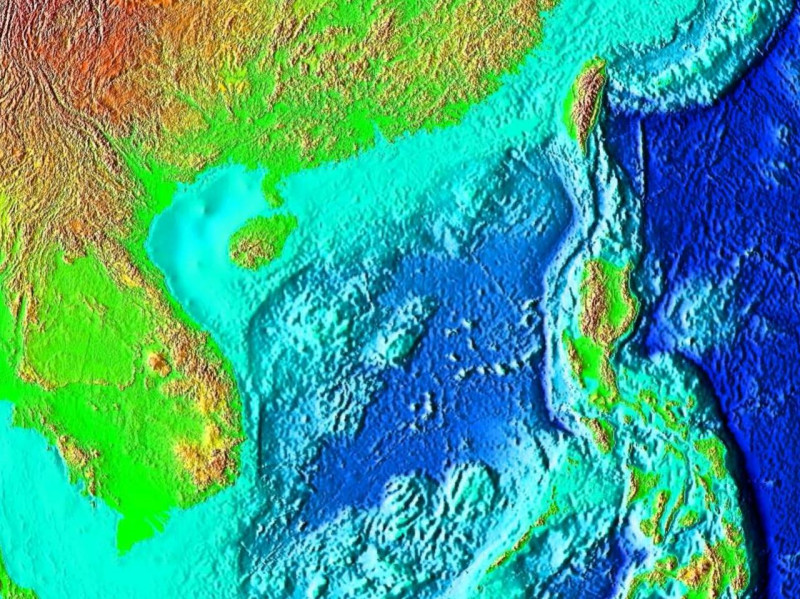The South China Sea, a marginal sea of the Western Pacific Ocean, is bordered by South China, the Indochinese Peninsula, Taiwan, the Philippines, Borneo, Sumatra, and the Bangka Belitung Islands. It covers approximately 3,500,000 km2. The sea connects to other bodies of water through various straits, including the Taiwan Strait, Luzon Strait, and Karimata Strait. The Gulf of Tonkin is part of the South China Sea.
1941: Japanese Naval Control
In 1941, the majority of the South China Sea came under Japanese naval control during World War II after Japan militarily acquired many surrounding South East Asian territories.
1953: IHO Definition
In 1953, the International Hydrographic Organization (IHO) defined the limits of the South China Sea in its Limits of Oceans and Seas, 3rd edition.
1970: Commercial Fishing Increase
From less than 4 million tonnes in 1970, the commercial fishing in Western Central Pacific increased to 11.7 million tonnes.
1974: Conflict in Paracel Islands
In 1974, a brief conflict over the Paracel Islands resulted in 18 Chinese and 53 Vietnamese deaths, after which China controlled the whole of Paracel Islands.
1986: IHO Recognizes Natuna Sea
In 1986, the International Hydrographic Organization recognized the Natuna Sea in a revised draft edition of Limits of Oceans and Seas, 4th edition, revising the southern limit of the South China Sea.
March 1988: Naval Clash at Chigua Reef
In March 1988, a naval clash occurred just south of Chigua Reef in the Spratly Islands, resulting in over 70 Vietnamese sailors killed.
July 2010: US Calls for Resolution
In July 2010, US Secretary of State Hillary Clinton called for China to resolve the territorial dispute, which China responded to by demanding the US keep out of the issue.
2010: Commercial Fishing in Western Central Pacific
In 2010, the Western Central Pacific accounted for 14% of the total world catch from commercial fishing.
2010: Commercial Fishing
In 2010, the Western Central Pacific accounted for 14% of the world's commercial fishing.
July 22, 2011: INS Airavat Incident
On July 22, 2011, India's INS Airavat was contacted by a vessel identifying itself as the Chinese Navy, stating that the ship was entering Chinese waters. The Indian Navy clarified there was no confrontation.
2011: Spratly Islands Dispute Escalation
Following an escalation of the Spratly Islands dispute in 2011, various Philippine government agencies started using the name West Philippine Sea.
September 2012: Administrative Order No. 29
In September 2012, Philippine President Benigno Aquino III signed Administrative Order No. 29, mandating that all government agencies use the name West Philippine Sea to refer to parts of the South China Sea within the Philippines' exclusive economic zone.
2012: Oil and Natural Gas Estimates
In 2012, the United States Energy Information Administration estimated very little oil and natural gas in contested areas of the South China Sea.
2012: Change in Strategy
Vietnamese analysis identifies the change in strategy that generated on going incidents as occurring since 2012.
January 2013: Philippines Initiates Arbitration
In January 2013, the Philippines initiated arbitration proceedings against China over issues surrounding the nine-dash line, characterization of maritime features, and EEZ. China did not participate.
2013: Oil and Gas Reserves Location
In 2013, the United States Energy Information Administration estimated that most of the proved or probable 11 billion barrels of oil and 190 trillion cubic feet of natural gas in the South China Sea exist near undisputed shorelines.
May 2014: China Establishes Oil Rig
In May 2014, China established an oil rig near the Paracel Islands, leading to multiple incidents between Vietnamese and Chinese ships.
July 2016: Arbitral Tribunal Ruling
On 12 July 2016, an arbitral tribunal ruled in favor of the Philippines, clarifying it would not rule on sovereignty but concluded China had no legal basis to claim historic rights within the nine-dash line and criticized China's actions in the Spratly Islands.
2016: Maritime Shipping Traffic
In 2016, $3.4 trillion of the world's $16 trillion maritime shipping passed through the South China Sea.
May 2017: Methane Clathrates Mining Breakthrough
In May 2017, China announced a breakthrough for mining methane clathrates, extracting methane from hydrates in the South China Sea.
December 2018: Controversial Proposals
In December 2018, retired Chinese admiral Luo Yuan proposed sinking one or two United States Navy aircraft carriers to break US morale, and Dai Xu suggested China's navy should ram United States Navy ships in the South China Sea.
2019: Trade Through South China Sea
Data from 2019 shows that the South China Sea carries trade equivalent to 5% of global GDP.
2019: US and China Work Out Rules of Engagement
In early 2019, during the US Chief of Naval Operations' visit to China, he and his Chinese counterpart worked out rules of engagement for when American and Chinese warships meet on the high seas.
November 2023: Government Support for Ruling
As of November 2023, 26 governments support the July 2016 arbitral tribunal ruling, 17 issued generally positive statements, and eight rejected it. The United Nations itself does not have a position.
Mentioned in this timeline

Hillary Diane Rodham Clinton is an American politician lawyer and...
The United States of America is a federal republic located...
India officially the Republic of India is a South Asian...
The Association of Southeast Asian Nations ASEAN is a regional...
World War II - was a global conflict between the...
China officially the People's Republic of China PRC is an...
Trending
13 days ago Lawsuit Filed Over KISD Stabbing; Killeen Principal Resigns From Ira Cross

Robert Kraft is an American billionaire businessman best known as the chairman and CEO of the Kraft Group His portfolio...
The School District of Philadelphia SDP established in is the largest school district in Pennsylvania and the eighth-largest in the...

6 months ago Zahara Jolie-Pitt and Boyfriend Spotted at Disneyland Amid Engagement Rumors
13 days ago Ranking the Worst Christmas Songs and Exploring Overrated, Underrated Holiday Music

7 months ago Matt Rife Announces Birmingham Comedy Tour Stop and Stars in New Rom-Com!
Popular

Candace Owens is an American conservative political commentator and author...

Ilhan Omar is an American politician currently serving as the...

XXXTentacion born Jahseh Dwayne Ricardo Onfroy was a controversial yet...

Tucker Carlson is an American conservative political commentator known for...

Charles James Charlie Kirk was a prominent American right-wing political...

Kashyap Pramod Patel is an American lawyer who became the...
